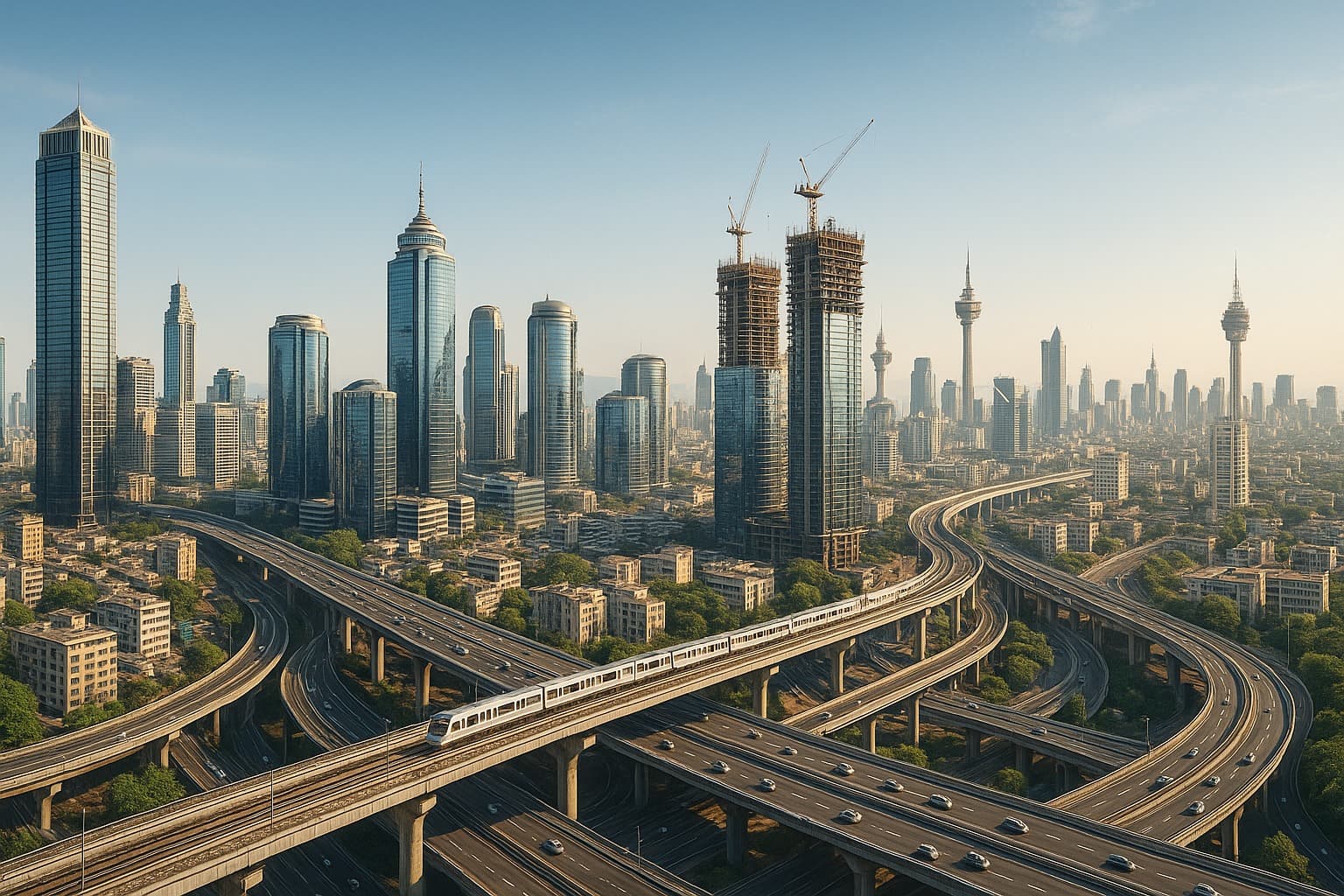India Real Estate Market Trends 2025: A Comprehensive Overview
Summary
India's 2025 real estate market showcases resilience and growth, driven by evolving lifestyles, tech adoption, and infrastructure. Residential and commercial sectors thrive, with opportunities in metros and emerging cities, offering diverse investment prospects.

India Real Estate Market Trends 2025?
The Indian real estate market in 2025 is a fascinating blend of resilience, ambition, and transformation. Across metros and emerging cities, buyers and investors are showing renewed confidence, navigating a landscape shaped by changing lifestyles, technological adoption, and infrastructural leaps. From residential apartments in bustling metros to sprawling townships in tier-2 and tier-3 cities, the property sector is witnessing dynamic growth that mirrors the aspirations of millions of Indians. This year, more than ever, real estate is not just about bricks and mortar—it is about lifestyle, long-term wealth, and the promise of a better tomorrow.
Residential Real Estate: The Pulse of the Market
At the heart of India’s property growth is the residential segment. Housing demand in India continues to rise, driven by young professionals, first-time buyers, and families seeking modern lifestyles. Affordable housing remains the main growth driver, especially in tier-2 and tier-3 cities like Jaipur, Kochi, Indore, and Lucknow. These cities offer high ROI for investors while providing more spacious, livable homes for buyers. Even metros like Mumbai, Delhi, and Bengaluru are witnessing demand shifts, with buyers opting for integrated townships, compact apartments, or eco-friendly housing.
Post-pandemic lifestyles have further reshaped residential demand. Work-from-home setups have made suburban living more attractive. Families are increasingly prioritizing greenery, open spaces, and proximity to good schools and hospitals. Developers are responding with integrated townships, sustainable projects, and amenity-rich communities to cater to these evolving needs. The rise of co-living spaces and compact homes reflects the changing demographic and lifestyle patterns in Indian cities.
Commercial Real Estate: Driving Growth Beyond Homes
While residential spaces drive ownership dreams, commercial real estate forms the backbone of investment growth. IT parks, co-working hubs, and industrial warehouses are witnessing significant demand, particularly in cities like Bengaluru, Pune, Hyderabad, and NCR. Companies expanding their footprint, especially in tech and logistics sectors, are creating a ripple effect on housing demand nearby.
Retail spaces are also evolving to meet consumer expectations, with developers embracing experience-driven shopping hubs and omnichannel integration. Industrial corridors and warehousing near new expressways and airports have emerged as lucrative real estate pockets. The India real estate market trends 2025 report emphasizes that commercial property remains a key pillar for long-term investment, offering steady returns and strategic growth opportunities.

Infrastructure and Connectivity: Transforming Markets
One of the most significant catalysts for India real estate growth in 2025 is infrastructure development. New metro lines, highways, and airport projects are turning previously remote areas into investment hotspots. For example, the Navi Mumbai International Airport and Noida International Airport have already boosted surrounding residential and commercial property values.
Connectivity does more than enhance property prices; it transforms lifestyles. Buyers now prioritize easy access to offices, schools, hospitals, and entertainment hubs. Developers strategically align projects near transport and infrastructure nodes, creating thriving communities with higher perceived value. The synergy between government planning and private development is redefining urban living and making emerging cities highly attractive investment destinations.
Technology and Proptech: Redefining Real Estate Engagement
Technology has become an inseparable part of India’s real estate transformation. Proptech solutions are reshaping the way buyers search, analyze, and invest in property. Virtual tours, AI-driven property recommendations, and online registration platforms have simplified transactions and enhanced transparency.
Developers increasingly incorporate smart building technologies, IoT-enabled amenities, and sustainable energy solutions in their projects. Buyers now expect seamless digital experiences, from exploring a property virtually to completing legal paperwork online. Real estate trends in metro and tier-2 cities indicate that technology adoption is a significant factor influencing property choices, making the market more dynamic and accessible than ever before.
Investment Opportunities: Where to Put Your Money
For investors, 2025 is a year of diverse opportunities. Metros continue to attract luxury and premium housing buyers, while tier-2 and tier-3 cities are emerging as high-ROI hubs. Affordable housing projects, supported by government incentives, are increasingly drawing both domestic and NRI investors.
Premium segments in Mumbai, Delhi, and Bengaluru still enjoy robust demand, especially for integrated townships, luxury apartments, and co-living spaces. Simultaneously, investors are eyeing cities like Lucknow, Jaipur, and Kochi for affordable housing projects with long-term appreciation potential. The real estate investment outlook India shows that diversification across segments and geographies is the key to success in 2025.
Policy Support: Stability and Buyer Confidence
Government policies continue to influence the market’s trajectory. Incentives for first-time homebuyers, stable home loan interest rates, and streamlined real estate regulations have strengthened buyer confidence. Policy support for sustainable construction and affordable housing encourages developers to diversify offerings, keeping pace with evolving market demand.
Monetary measures, including repo rate stability and favorable RR rate revisions, play a critical role in affordability. The festive season often sees a surge in property registrations, reflecting both buyer optimism and favorable financing conditions. Stable policies, combined with rising buyer confidence, ensure that the market remains resilient even amid economic fluctuations.

Sustainability: Green Living Matters
Sustainability is no longer a niche trend—it is central to Indian real estate in 2025. Eco-conscious buyers demand green-certified homes, energy-efficient construction, and wellness-oriented amenities. Developers are responding with solar energy solutions, rainwater harvesting, and low-carbon buildings.
Urban projects now include green open spaces, parks, and eco-friendly designs, reflecting lifestyle priorities alongside environmental responsibility. This trend not only boosts property value but also contributes to healthier, more livable cities. Millennials and HNIs, in particular, are driving this shift toward sustainable living, which is gradually becoming a standard expectation in residential projects.
Market Outlook: The Road Ahead
Looking beyond 2025, the Indian real estate market appears poised for sustainable, diversified growth. Residential demand, fueled by affordability, connectivity, and lifestyle preferences, will continue to rise. Commercial spaces will expand steadily, anchored by IT parks, logistics hubs, and evolving retail models. Emerging cities and smart townships will attract investors seeking high ROI, creating a balanced market across metros and smaller towns.
Integration of technology, sustainability, and robust policy support ensures that buyers, investors, and developers are well-positioned to benefit. 2025 is not merely a year of transactions—it is a transformative period shaping the next decade of Indian real estate.
Conclusion
India’s real estate market in 2025 is more than just bricks and mortar; it reflects the aspirations, lifestyles, and dreams of millions. From suburban homes to luxury apartments, from tier-2 city townships to metro commercial hubs, the market is dynamic, resilient, and innovative. Infrastructure, technology, sustainability, and policy support are harmonizing to create opportunities that are attractive to buyers and investors alike.
The post-pandemic shift in work, lifestyle, and investment strategies has opened new avenues for housing demand, commercial growth, and green living. With informed decisions, strategic investments, and awareness of market trends, 2025 promises a vibrant, opportunity-rich era for Indian real estate.
Summary (100 words)
In 2025, India’s real estate market is thriving across residential and commercial sectors. Urbanization, suburban growth, and work-from-home lifestyles are reshaping housing demand, while infrastructure projects like expressways and airports boost property values. Tier-2 and tier-3 cities are emerging as lucrative investment hubs alongside premium metros. Technology adoption, sustainable construction, and favorable government policies are transforming buyer expectations and developer strategies. Affordable housing and luxury segments are both witnessing growth. Overall, 2025 reflects a dynamic, resilient, and opportunity-rich market, offering smart buyers and investors avenues for lifestyle upgrades, long-term returns, and meaningful urban living.
